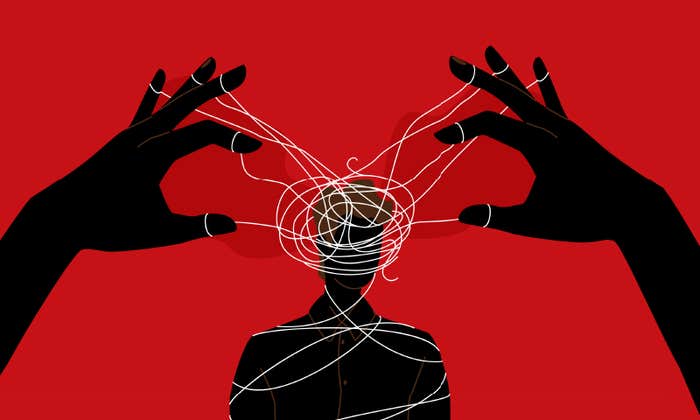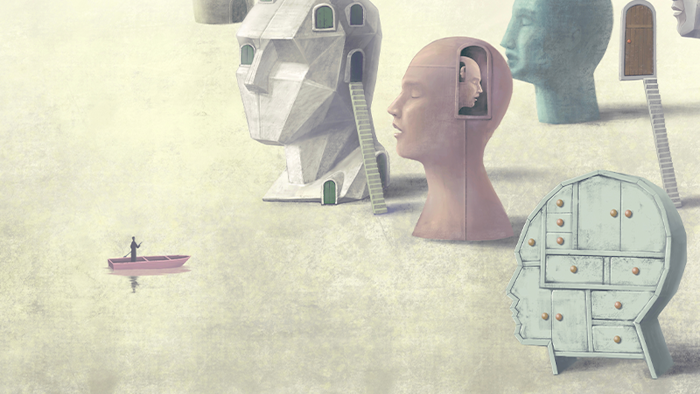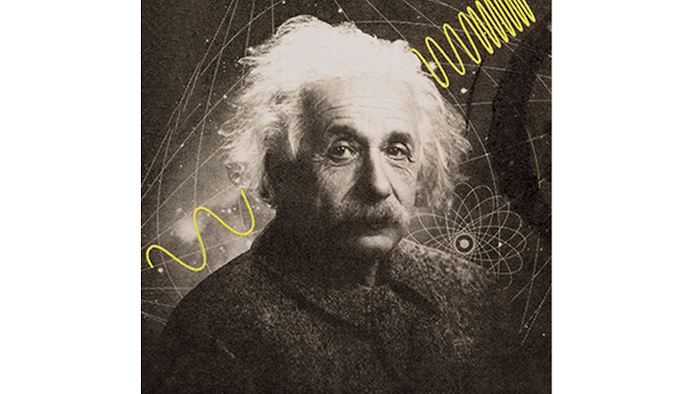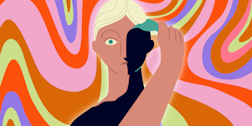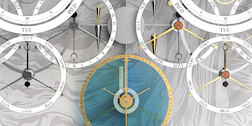When did you realize you were a machine? A fancy machine, for sure. But one whose parts and operations can be described like the components of a computer. I remember a day in 2012 when this thought pierced me to the bone. I was in the lab of John Donoghue at Brown University. Donoghue is a professor of neuroscience and a pioneer in the development of brain-computer interfaces. With easygoing authority, Donoghue was detailing for me the ways he and his colleagues taught Cathy Hutchinson, a 58-year-old woman who had lost control of her limbs in a stroke, to control a robotic arm with her thoughts and sip coffee from a bottle. It was a matter of basic math and biology, Donoghue said, with, yes, some sophisticated technology.
Surgeons implanted a microelectrode array with 100 sensors in Hutchinson’s motor cortex, the brain’s control center for movement. Donoghue then had Hutchinson watch a cursor moving across a computer screen and imagine she was moving the cursor with a mouse. As she pictured moving the cursor left and right, forward and backward, the microelectrodes picked up electrical “spikes” in her neurons. Donoghue’s team recorded the pattern of spikes associated with each direction, then programmed the robotic arm to recognize them.
When it was coffee time, Hutchinson wore an electronic device on her head that looked like a tiny top hat. It registered the spikes from her implanted array and relayed them to the robotic arm. The woman, who had not been able to feed herself for 14 years, directed, with her thoughts alone, the robotic arm to pick up the bottle and bring it to her lips. Donoghue showed me a video of the historic drink. When Hutchinson finished her coffee and had the robotic arm remove the straw from her mouth, a smile glowed across her face.
I was startled. Human movement, and by extension, human feelings, can be charted (with a little help from a probability theorem) right down to the binary activity of specific neurons? Donoghue smiled. He was standing beside the metallic blue robotic arm that Hutchinson had used. “Well, the brain is a machine,” he said. “It’s just a biological machine, right?” Yes, but didn’t that formulation seem a bit, well, reductive, lacking humanity?
Studying science up close has caused me more than once to face an image of myself as an electrochemical robot, built on nature’s assembly line.
“Humanity” was no doubt the wrong term for my opprobrium. Donoghue had been patient with me all afternoon. His explanations were often personal. As a child, Donoghue suffered from Leggs-Calvé-Perthes disease, which prevented him from walking for two years. In his first job after college, he worked at the Walter E. Fernald State School, an institution for the mentally handicapped. “I was looking at brains in the lab and then looking out the window at people who had brain diseases that completely took away their humanity, their ability to interact,” Donoghue offered. “I’ve been trying to understand what the brain is doing because to me the brain is the organ of our humanity. It gives us our mental life, and that makes us what we are.”
After I left the lab, I walked down the sloping green lawns of the Brown University campus, through the red brick colonial halls, reflecting on the notion that our brain is a machine. It’s technically true, I guess, but coming from Donoghue, it felt kind and wise. He and his colleagues had shown science at its best, restoring humanity to a person who had lost it. But as I continued to walk toward downtown Providence, picturing my thoughts as bursts of little numbers, I felt unsettled. It’s taken me a good while to figure out why.
I’ve spent the past decade and more engaged in science, but I came of age in the humanities. Growing up, I schooled myself in literature and music. I lived for the transcendent—the infinite metaphor, the ageless melody—that struck me without calculation. My favorite arts were adventures to places I could never imagine, but when I got there, felt at home. Reading fiction was a continuous discovery of myself. I always felt like a bigger person after finishing a novel I loved. My passion for the arts launched my career in journalism. I began covering music and ranged to the environment, politics, crime, sports, and, now that I think of it, most every dance in the human parade.
I leaped into science journalism because I wanted to continue my journey to new places. I had always read popular science but was now deep into the minute details of academic journals, spending hours in the field with scientists. But studying science up close has caused me more than once to face an image of myself as an electrochemical robot, built on nature’s assembly line. Neurotransmitters explain this behavior, hormones that. Goodness, you think, I have no free will, I’m just a bunch of parts off nature’s shelf. It can be an abject feeling.
But I began to find my way out. I’m sure this sounds naïve to real scientists, but I’ve learned in the layers of research, answers are on the surface, mysteries in the depths. When I was unnerved by the mechanics of science, it was because I felt the weight of a final definition pressing on me. But there is none. The investigation of nature has no end, and neither does the complexity of its interrelationships. A machine with 1,000 trillion connections, as our brain has, has an infinity no less than a magnificent poem. Science opens up the world rather than closes it down. Fittingly, an artist helped me arrive at this conclusion.
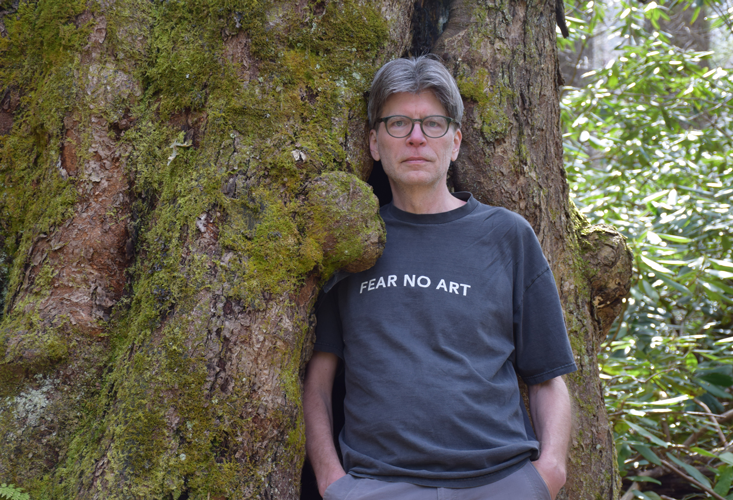
Unlike any novelist I’ve read, Richard Powers brings the natural world to life through science. Every exceptional artist peels away clichés and reveals the world anew. But how often does an artist magnify the complexities of nature, and our relationship to them, through a command of science? In dramatic plots that invariably turn on humans’ oversized control over nature, Powers has ushered readers into the labs of genetics, pediatric medicine, artificial intelligence, neurobiology, and this year, in his twelfth novel, The Overstory, dendrology, the study of trees, and in particular their remarkable biotic communication.
Powers set the stage for his philosophy of science in one of his early novels, The Gold Bug Variations, released in 1991, which portrays the life of a research scientist who helps crack the genetic code. The “purpose of all science, like living, which amounts to the same thing, was not the accumulation of gnostic power, fixing of formulas for the names of God, stockpiling brutal efficiency, accomplishing the sadistic myth of progress,” Powers wrote. “The purpose of science was to revive and cultivate a perpetual state of wonder. For nothing deserved wonder so much as our capacity to feel it.”
Because Powers has succeeded so wonderfully in mixing science into moving stories, I was anxious to talk him about the kind of experience I had with Donoghue. Today Powers lives in a split-level wooden house tucked into the Tennessee foothills of the Smoky Mountains. I went to see him there this April.
Richard Powers speaks softly but carries a big intellect. We sat at a kitchen table where every window in the room looked out on trees. I told him about my old dread of seeing into the gears of nature. He knew the theme well. “Grasping the underlying material principles of life has profoundly changed our self-conception,” Powers said. “But I’m pushing back against this notion that a mechanistic view reduces our humanity. It doesn’t. There’s a beautiful Lewis Thomas essay, ‘On Matters of Doubt,’ in which he says the common denominator between science and art is bewilderment. I’m sure you know it.”
I do indeed. Thomas, a physician, who died in 1993, is my exemplary science writer. He was an accomplished scientist who wrote from experience and late-night reflection. His lucid essays, laced with wit and humility, may be the closest that science writing has come to prose poetry. In “On Matters of Doubt,” from the early ’80s, Thomas wrote, “We would be better off if we had never invented the terms ‘science’ and ‘humanities’ and then set them up as if they represented two different kinds of intellectual enterprise.” Despite the fact we did, he wrote, there was a “common earth beneath the feet of all the humanists and all the scientists, a single underlying view,” and that view “is called bewilderment.” “Most things in the world are unsettling and bewildering, and it is a mistake to try to explain them away; they are there for marveling at and wondering at, and we should be doing more of this.”
Powers loved Thomas’ idea that bewilderment was the common ground between science and art. “The word ‘bewilderment’ has such a great etymology,” he said. “It means to partake in the state of being wild. It’s lovely to think that amazement is a recognition the wild is part of us. There’s amazement and there’s awe. It’s largely a function of literacy that someone, because of their natural capacities, but more often because of their environmental encouragement or discouragements along the way, believes the world is properly apprehended through one of those kinds of awes—the humanities or science—and not the other. Then the other kind of awe is going to seem like an incursion, it’s going to seem like a reduction, it’s going to seem a diminishment, right?”
I suggested to Powers that divide arises from a fear that science—biology in particular—robbed the romance from human life. That was my fear when I was with Donoghue in Providence. “The fear that deep biologism creates in a lot of people may be related in a way to the fear of the naïve music listener to hearing that they’re being jerked around by a deceptive cadence,” Powers said. “The fear is that mechanism will replace mystery. It doesn’t. It multiplies mystery many orders of magnitude. I mean, which is a more amazing story: That some omnipotent force, who by coincidence looks just like us, whipped up everything ex nihilo, created us like Geppetto created Pinocchio, then set us loose to ponder his magnificence, or that a few simple forces, through countless trillions of steps in an unsponsored process produced people capable of understanding the nature and function of genes? The second story feels many orders of magnitude more mysterious and overwhelming than any supernatural explanation.”
“So long as science has a program of being in charge, it will be at war with art.”
I know that overwhelming feeling well. In the pages of cosmology and evolution and neurology, I’ve been left wondering more than once over questions like how did consciousness arise and why. Powers has stitched the messy colors of human emotion into the big questions and pursuits of science. You feel the importance of science in the byways of his narratives and sense the deeper you travel into the systems of the natural world, the wider your capacity for appreciation of it grows.
Again, Powers said, consider music. “The reality is analyzing music with specific names like major tonics and minor keys, which seem counter to the mere surrender to music, are incredible intensifiers to those who know what they mean, and who understand the decisions on the part of the composer to produce certain affective responses. The people who are in a position to be analytical about that affect, I would argue, have a more intensely affective response to it. And there’s nothing you can’t bring into that equation which won’t further intensify your depth and understanding of the way that beauty is made.”
The music analogy hit home for me. Over a lifetime of listening to and loving music, studying its history and structures, often through interviews with musicians and composers themselves, I have felt my musical emotions grow. Knowledge pries open feelings you never knew you had. How remarkable to realize science does the same. Being exposed to the neurons that make our limbs move, or learning the modal scales that distinguish Miles Davis’ Kind of Blue, are not ends in themselves. They are journeys into the depths of beauty and humanity—a powerful lesson for which I have writers like Powers and Thomas to thank. They remind me that artists and scientists share the same drive for exploration and revelation, that scientists and artists elevate one another. “That’s our superpower, that’s humankind’s superpower—to be an artist and a scientist and to find ways in which each one of those capacities enhances and gives depth to the other,” Powers said.
During the course of our conversation, Powers returned to his latest novel, The Overstory, to spotlight the bridge between science and art. The novel revolves around a host of disparate activists who battle timber companies to protect the remaining old-growth forests in the Pacific Northwest. Understanding the nature of trees and their role in ecosystems, which include us, was critical to preserving their habitats and ours, the novel offers. Success didn’t stem from textbook knowledge about trees, it grew from realizing we shared the world with trees in mutual interdependence. “We are mere components in complicated interdependent and reciprocal processes,” Powers said. In other words, we are not in charge. “So long as science has a program of being in charge, it will be at war with art. Because the best thing that art does, the thing that’s really in the corner of the artist, is that sense of surrender to things larger than yourself.”
Eventually Powers and I took our talk to the mountains. We hiked up a winding trail, past the uniform trees in a second-growth forest to the big, unruly ones in an ancient grove. Under a dark canopy of trees, surrounded by patches of wildflowers and carpets of moss, I was delighted, courtesy of Powers, to learn the names of the trees and the ecological processes by which they had prospered. As he spoke, I thought to myself how science can re-enchant nature when our hope for it ran dry. Best of all, though, were the moments when I stopped thinking about definitions altogether, and simply let go into nature.
Kevin Berger is Nautilus’ features editor.
Lead image: Margarita Steshnikova / Shutterstock











